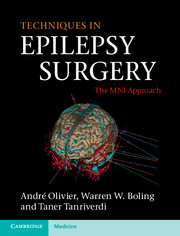Book contents
- Frontmatter
- Contents
- Acknowledgment
- Preface
- 1 History of epilepsy surgery
- 2 The search for the epileptic focus: investigation of the surgical candidate
- 3 Surgical anatomy
- 4 Neuronavigation and preoperative brain mapping
- 5 Stereoelectroencephalography (stereotactic intracranial recording)
- 6 Anesthesia and awake procedure
- 7 Peroperative brain mapping
- 8 Endopial resection (intervascular endopial gyral emptying)
- 9 Surgery of temporal lobe epilepsy: cortico-amygdalohippocampectomy
- 10 Surgery of temporal lobe epilepsy: transcortical selective amygdalohippocampectomy
- 11 Surgery of central area epilepsy
- 12 Surgery of frontal lobe epilepsy
- 13 Surgery of parietal lobe epilepsy
- 14 Surgery of insular lobe epilepsy
- 15 Surgery of occipital lobe epilepsy
- 16 Hemispherectomy
- 17 Callosotomy
- 18 Epilepsy and brain tumors
- 19 Surgical treatment of cortical dysplasias
- 20 Reoperations in failed epilepsy surgery
- 21 Alternative procedures in surgery for epilepsy
- 22 Complications of epilepsy surgery
- 23 Quality of life after epilepsy surgery
- Index
- References
21 - Alternative procedures in surgery for epilepsy
Published online by Cambridge University Press: 05 October 2012
- Frontmatter
- Contents
- Acknowledgment
- Preface
- 1 History of epilepsy surgery
- 2 The search for the epileptic focus: investigation of the surgical candidate
- 3 Surgical anatomy
- 4 Neuronavigation and preoperative brain mapping
- 5 Stereoelectroencephalography (stereotactic intracranial recording)
- 6 Anesthesia and awake procedure
- 7 Peroperative brain mapping
- 8 Endopial resection (intervascular endopial gyral emptying)
- 9 Surgery of temporal lobe epilepsy: cortico-amygdalohippocampectomy
- 10 Surgery of temporal lobe epilepsy: transcortical selective amygdalohippocampectomy
- 11 Surgery of central area epilepsy
- 12 Surgery of frontal lobe epilepsy
- 13 Surgery of parietal lobe epilepsy
- 14 Surgery of insular lobe epilepsy
- 15 Surgery of occipital lobe epilepsy
- 16 Hemispherectomy
- 17 Callosotomy
- 18 Epilepsy and brain tumors
- 19 Surgical treatment of cortical dysplasias
- 20 Reoperations in failed epilepsy surgery
- 21 Alternative procedures in surgery for epilepsy
- 22 Complications of epilepsy surgery
- 23 Quality of life after epilepsy surgery
- Index
- References
Summary
Introduction
This chapter will discuss techniques that depart from the classical epilepsy surgery of seizure focus resection. The treatments vagus nerve stimulation and multiple subpial transection discussed below are currently being used and are generally accepted as standard surgical options, but brain stimulation and radiosurgery are continuing to be studied to define their roles in the treatment of intractable epilepsy. For the newer therapies, we cannot know at this time whether they will be embraced as a useful and efficacious treatment option for our patients. With that caveat in mind, the goal of this chapter is to serve as an introduction to the current state of knowledge for investigational approaches, as well as to describe the indications and surgical technique for alternative procedures that have become accepted for use in surgery for epilepsy.
Multiple subpial transections
Often the most difficult and complex treatment decisions are in patients with a seizure focus that involves important functioning areas. In some patients, a minor neurological deficit may be acceptable for a reasonable chance at seizure freedom. However, if the complete resection of a seizure focus poses an unacceptable risk to neurological function, an alternative technique such as multiple subpial transection (MST) can be considered. The technique of MST was refined in animals by Morrell and colleagues. It was first utilized in humans by John Handbery in three patients and later translated to a large series of patients by Whisler at the Rush Epilepsy Center in Chicago.
- Type
- Chapter
- Information
- Techniques in Epilepsy SurgeryThe MNI Approach, pp. 254 - 268Publisher: Cambridge University PressPrint publication year: 2012



